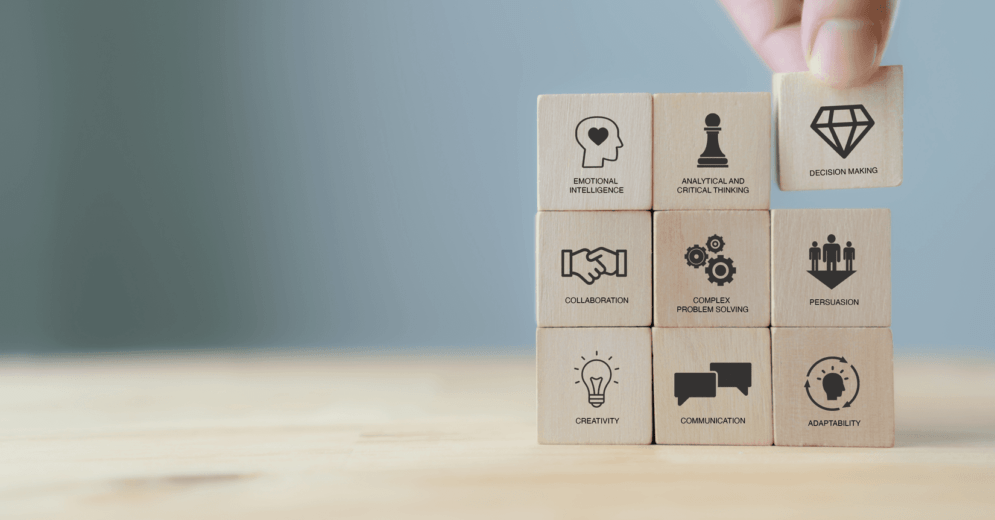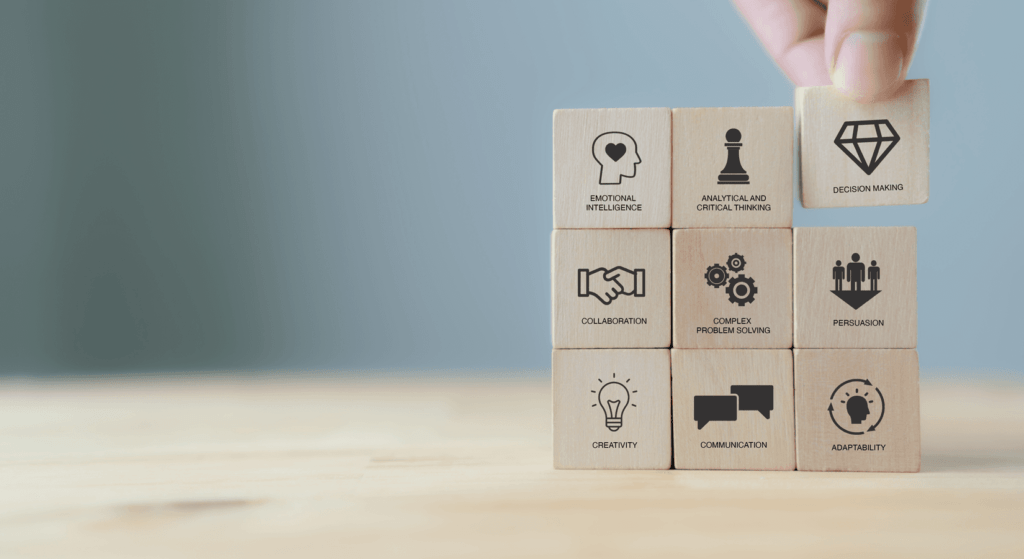If you're looking to transition into UX or are already in the process, you've probably realized that this journey can be quite challenging.
It's not just about having the technical skills; there are other important considerations, such as building a UX portfolio and having the necessary soft skills.
Among all this, it's natural to have doubts and frustrations. At times, you might even feel the urge to give up. However, certain mindsets and behaviors will help you keep consistent and determined to achieve your goals in the face of new challenges.
In this article, we will delve into some key characteristics and soft skills that are crucial for individuals in this pivoting phase. These skills will help you stay resilient throughout the process of starting a career in UX Design.
Soft Skills: The Key to Transitioning into UX and Achieving a Balanced and Successful Life
When it comes to making a career change, it's not just technical knowledge that matters. Soft skills encompass a range of behavioral and interpersonal abilities that are valuable in various aspects of our lives. They help us adapt, communicate effectively, and navigate the challenges that come with transitioning to a new career path.
While technical expertise is important, it's the soft skills that truly differentiate and elevate professionals in their chosen fields. These skills include problem-solving, adaptability, resilience, teamwork, and a growth mindset.
During a career transition, these behavioral skills are essential for building relationships, networking, and showcasing your value to potential employers. They enable you to face uncertainties, overcome obstacles, and confidently embrace new opportunities.
By honing your soft skills, you not only evolve as a professional but also develop the flexibility and discipline needed to go through the complexities of a career change.
So, as you embark on your journey to a new career, remember the impact of a good set of soft skills. They are the foundation for a successful transition, enabling you to thrive and excel in your chosen path.
Essential soft skills to start a career in UX Design

1) Resilience
Career transitions can be challenging, and it's completely natural to face obstacles and moments of frustration along the way.
But let me tell you, resilience is the key to overcoming those challenges and keeping your motivation high. It's about learning from setbacks, refusing to give up, and pushing through the difficulties.
When you lack resilience, it's easy to give up too soon or feel demotivated when you encounter the challenges that inevitably come your way during the transition to UX.
Picture this: you're on your journey to UX Design, and suddenly, you face resistance or rejection in your search for opportunities. It's in these moments that resilience becomes your superpower.
It's about bouncing back quickly, learning valuable lessons from the feedback you receive, adjusting your approach, and moving forward with unwavering determination.
Here goes a few tips on how to develop your resilience:
- Seek inspiration from the success stories of individuals who have faced similar challenges while making their own transitions into the world of UX Design.
- Dive into books, articles, or biographies of professionals who have triumphed in their career shifts, and let their experiences motivate and guide you.
- Practice self-compassion and self-awareness. Recognizing your own strengths will serve as a support pillar the next time you encounter adversities.
- Join a community. Whether through participating in groups of like-minded individuals or seeking guidance from a mentor who can provide valuable insights and help strengthen your resilience.
Remember, building resilience is a personal journey. Still, it's one that will empower you to navigate the twists and turns of your career transition and emerge stronger than ever.
Keep pushing forward, stay determined, and embrace the challenges that come your way. Your journey into UX Design awaits, and with your resilience as your guide, there's no doubt that you'll thrive and achieve your goals.
Reading tip: How To Use Storytelling To Promote Your Career
2) Patience
Moving into UX (or any career change) requires patience, and it's important to acknowledge that the transition won't happen overnight.
When dealing with a career change, investing time and effort into acquiring new knowledge and skills without getting too anxious about it is essential. So patience is crucial. It allows you to navigate the learning process better, practice your skills, and gradually gain experience.
Keep in mind that every small step you take contributes to your overall progress. To nurture your patience, it's essential to understand that switching to UX is a gradual journey.
Other tips that can help you build patience:
- Set realistic goals and be willing to dedicate time to your learning and development.
- Create a flexible yet consistent schedule that allows you to study and practice your UX Design skills regularly.
And most importantly, celebrate every little achievement along the way. Remember, progress is progress, no matter how small.
Stay open to adjusting your expectations as you move forward. Embrace the process, knowing that each moment you invest in your growth is a stepping stone toward your goals. Take pride in your dedication and be patient with yourself.
3) Organization

Transitioning to UX Design also requires a good dose of organization. It's all about managing your time effectively, setting realistic deadlines, and prioritizing tasks. When you're organized, you make the most out of your time and resources.
Without a clear plan, it's easy to lose track of tasks and commitments. To help you boost your organizational skills, you can try to find a system that works for you.
Whether using calendars, task management apps, or spreadsheets, find a method to help you plan and track your progress. Break your goals into smaller, manageable tasks with reasonable deadlines. Take time regularly to review and readjust your priorities.
Consider checking out online courses and resources on personal organization. They can give you some extra insights and techniques to level up your organizational game.
Staying organized is like having a trusty sidekick on your journey to success. So stay focused, and let the magic of organization guide you to a thriving career in UX Design.
4) Networking
Building a strong network in the UX Design field is essential for unlocking new career opportunities.
To expand your network, actively participate in industry events, conferences, and online communities tailored to UX Design. Seek out and contribute to lively discussions and specialized forums where UX professionals gather.
You can also connect with influential professionals in UX Design through LinkedIn. So be open to meeting new people, exchanging ideas, and collaborating on exciting projects.
Effective networking opens doors to potential job prospects, partnerships, and mentorship that can accelerate your journey toward transitioning into UX.
Additionally, consider exploring volunteering opportunities related to UX Design roles. Engaging in these contexts allows you to showcase your passion, exchange innovative ideas, and establish meaningful relationships that propel your career forward.
5) Courage
Courage is essential because it empowers us to take risks and pursue our passions and aspirations. Without it, you may hesitate to make the necessary changes to improve your life or let fear hold you back from realizing your true potential.
It takes courage to challenge the status quo, think outside the box, and pursue your dreams. Ultimately, courage is the driving force that propels us forward, enabling us to overcome self-doubt, embrace change, and seize opportunities for personal and professional growth. It is the catalyst that empowers us to step into a new career with enthusiasm, resilience, and believing in our ability to succeed.
6) Flexibility
Flexibility is somewhat related to resilience. In this sense, being flexible means being able to deal with unexpected events and situations that deviate from the plan.
Transitioning to UX requires a well-defined plan with various activities scheduled to achieve goals within a determined timeframe. However, unforeseen circumstances can arise, requiring you to readjust and adapt your plans.
A lack of flexibility can easily lead to feelings of frustration, increasing the likelihood of you giving up midway.
It's important to remember that we don't have control over everything and that unforeseen events will occur. Therefore, being flexible is a crucial skill that allows us to adapt in such moments.
7) Prioritization

Transitioning to UX Design requires setting clear goals and defining the necessary steps to achieve them. The ability to prioritize your studies and objectives will allow you to focus on the most relevant areas and make informed decisions about the path to follow.
Identify the skills you need to develop and what you need to study to practice UX Design. Then, set priorities and plan your development according to these goals.
Without a clear definition of priorities, it can be harder to focus on studies, search for job opportunities, or make strategic decisions.
Here goes an example of what you can do to prioritize your studies:
- Identify clear goals for your career transition;
- List the skills and the topics you need to study;
- Establish an action plan to achieve those goals;
- Set realistic milestones and deadlines for each stage of your progress;
- Learn to say 'no' to activities or distractions that are not aligned with your objectives.
You can also seek guidance from professionals in the field to gain valuable insights on which skills are a priority and how to structure your development process.
Soft skills are along for the ride
Soft skills are an important part of continuous learning. They play a key role in overcoming challenges and advancing professionally.
The soft skills mentioned earlier are just a few examples of the many skills you can learn throughout your life. Even after landing your first UX design role, it's important to keep working on your soft skills.
Here are a few examples:
- Communication: Being able to communicate clearly and effectively is crucial for a UX designer. You need to express your ideas, defend your design decisions, and collaborate well with your team.
- Empathy: Empathy is essential in UX Design. To create meaningful experiences for users, it's important to understand their needs, expectations, and desires.
- Teamwork: Working as part of a team is vital for the success of a UX project. You should be able to collaborate, share ideas, listen, and work well with other professionals like developers, researchers, and marketing specialists. Team synergy is what helps create exceptional products and services.
To learn more about the soft skills that will help you stand out as a UX Designer, check out the article: The 8 Essential Skills for a Career in UX/UI Design.
If you would like to receive more career-related content on UX Design directly in your inbox, then go ahead and sign up for our newsletter!








